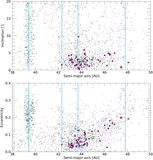Light Curves and Rotational Properties of the Pristine Cold Classical Kuiper Belt Objects
Abstract
We present a survey of the rotational and physical properties of the dynamically low inclination Cold Classical (CC) trans-Neptunian objects (TNOs). The CCs are primordial planetesimals and contain information about our solar system and planet formation over the first 100 million years after the Sun’s formation. We obtained partial/complete light curves for 42 CCs. We use statistical tests to derive general properties about the shape and rotational frequency distributions of the CCs and infer that they have slower rotations and are more elongated/deformed than the other TNOs. On the basis of the full light curves, the mean rotational period of the CCs is 9.48 ± 1.53 hr compared to 8.45 ± 0.58 hr for the rest of the TNOs. About 65% of the TNOs have a light-curve amplitude below 0.2 mag compared to the 36% of CCs with small amplitude. We present the full light curve of one likely contact binary, 2004 VC131, with a potential density of 1 g cm-3 for a mass ratio of 0.4. We have hints that 2004 MU8 and 2004 VU75 are perhaps potential contact binaries, on the basis of their sparse light curves, but more data are needed to confirm this finding. Assuming equal-sized binaries, we find that ∼10%-25% of the CCs could be contact binaries, suggesting a deficit of contact binaries in this population compared to previous estimates and to the (∼40%-50%) possible contact binaries in the Plutino population. These estimates are lower limits and may increase if nonequal-sized contact binaries are considered. Finally, we put in context the results of the New Horizons flyby of 2014 MU69.
- Publication:
-
The Astronomical Journal
- Pub Date:
- June 2019
- DOI:
- 10.3847/1538-3881/ab18a9
- arXiv:
- arXiv:1904.02207
- Bibcode:
- 2019AJ....157..228T
- Keywords:
-
- Kuiper belt objects: individual: 2004 VC131;
- 2004 MU8;
- 2004 VU75;
- techniques: photometric;
- Astrophysics - Earth and Planetary Astrophysics
- E-Print:
- AJ, In press
